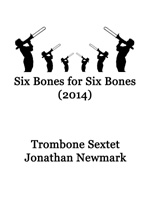Newmark Six Bones for Six Bones
Trombone Sextets

-
Newmark
Six Bones for Six Bones [4T,2B]
Six Bones for Six Bones was first performed in 2015 by the trombone studio of the College-Conservatory of Music, University of Cincinnati. Each movement of this sextet describes a different skeletal bone. The calcaneus, or ankle bone, is key in jumping or leaping; accordingly, the trombones repeatedly jump across partials. The ossicles are small bones in the inner ear, dysfunction of which can cause ringing in the ears, or tinnitus. The mandible, or jawbone, is essential in speech, or "jawboning". The frontal bone overlies, and co-evolved with, the frontal lobe of the brain, responsible for higher functions, as in holding two contradictory thoughts at once. The femur or thigh bone is necessary for walking, or, as here, learning new dance steps. Grant's textbook of anatomy states that, in forming a fist to strike a blow, the impact surface falls on the second and third metacarpals, or proximal bones of the dominant hand. So the last movement is something of a boxing match.Jonathan Newmark - violist, pianist, and composer - received his MM degree in composition from the University of Cincinnati College-Conservatory of Music in 2015. His works have premiered at the Charlotte New Music Festival, the Walden School Creative Musicians' Retreat, and with the Trinity Chamber Orchestra of Washington, DC. His 1997 String Trio co-won the Southeastern Composers Competition at Old Dominion University in 2000. A 1974 graduate of Harvard College, he earned his MD degree from ColumbiaUniversity College of Physicians and Surgeons in 1978, and is a board-certified neurologist, retired Colonel in the US Army Medical Corps, and one of the nation's leading authorities on medical response to chemical warfare and terrorism. He lives in the Virginia suburbs of Washington, DC. -the publisher
-
- Category: Trombone Sextets
- Item: 110112
- Grade/Level:
- Price: $27.00
-
(usually ships in 10 to 15 days)
